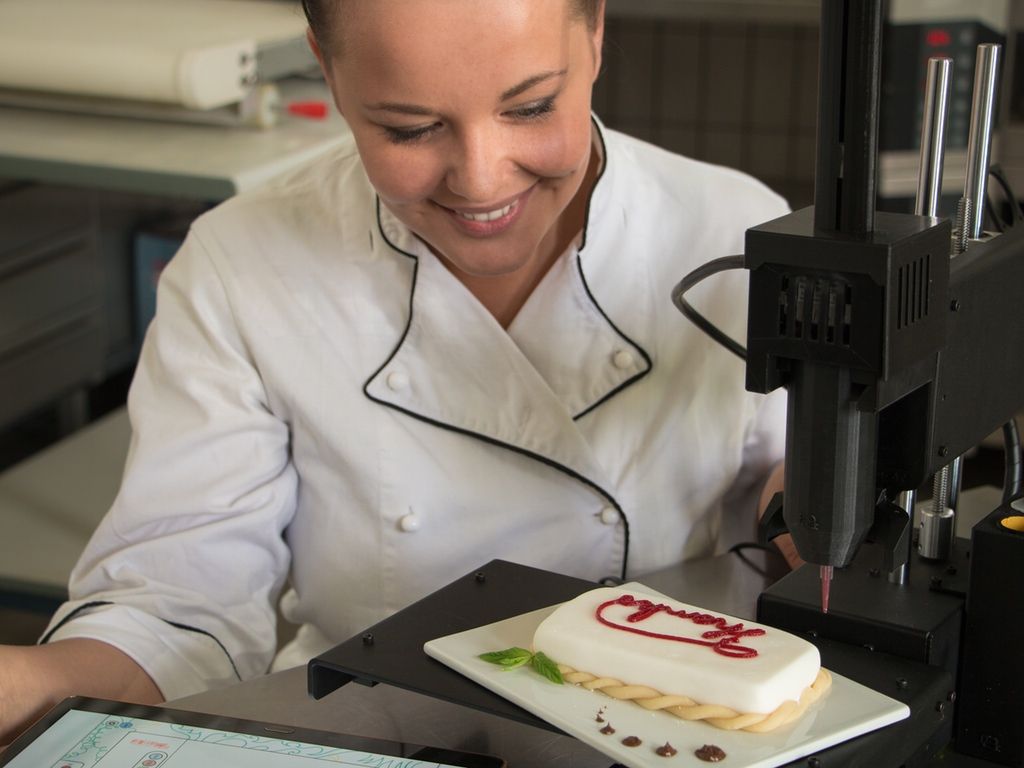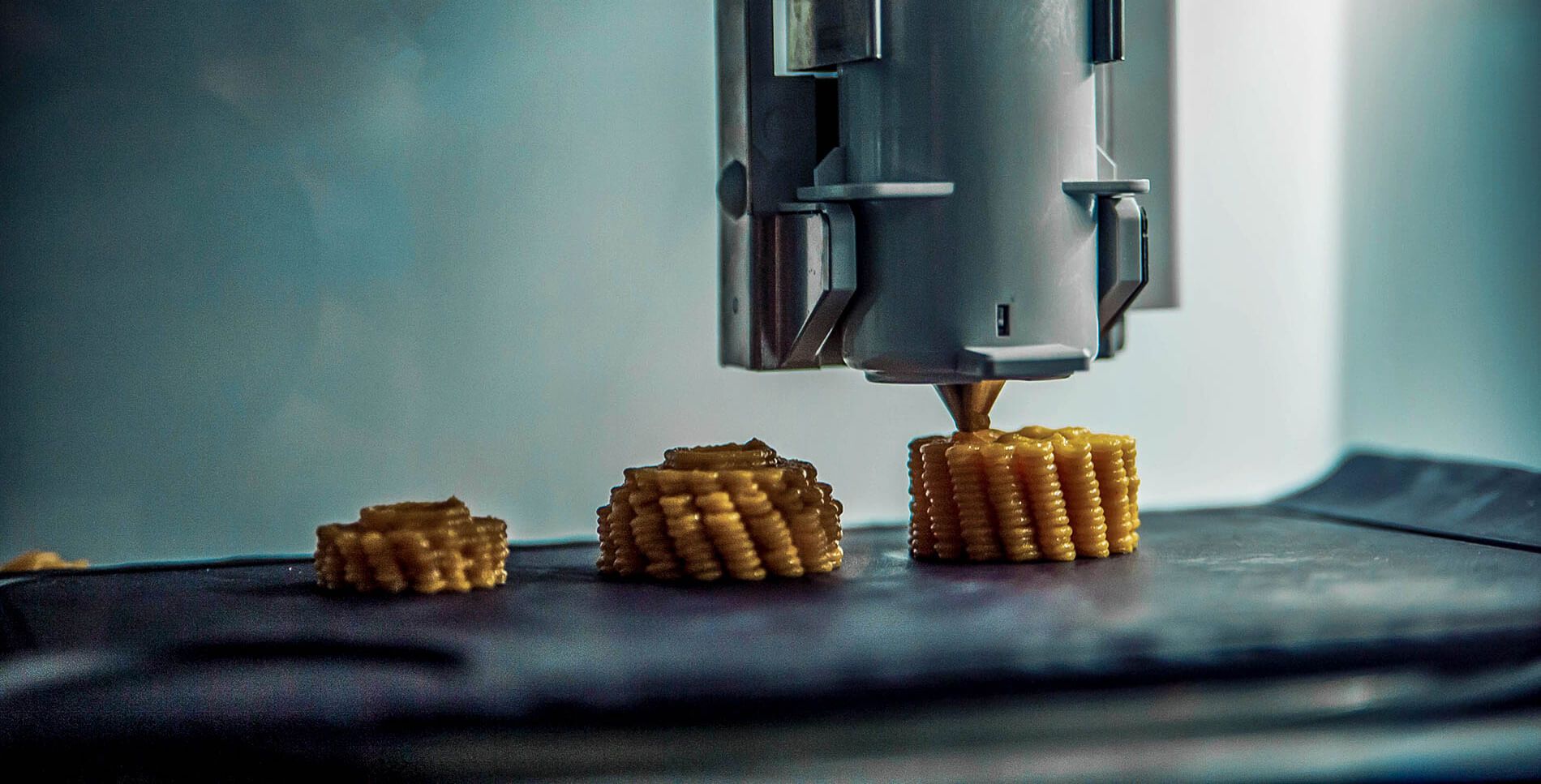We live in times where reality is surpassing even our craziest nonage imaginations. Back then, a 90s child sat in her room and wondered if her favorite pizza could appear out of thin air in front of her. Today, that child is witnessing the advent of 3D printed food.
The introduction of 3D printers has altered many facets of life, and food is the next industry to be transformed. Currently, food that takes you hours to prepare gets eaten in minutes, and where some people enjoy cooking, there are those of us foodies who despise the kitchen. For the latter, the automation of cooking would be a dream come true.
But before we get into 3D printed food, let’s see what 3D printing actually means.
What is 3D Printing?
3D printing is a process where molten or semi-soft filament is ejected out of a nozzle and deposited layer by layer, one on top of the other, to form the desired shape.
3D printing, called additive manufacturing, is the opposite of subtractive manufacturing, i.e., the mainstream manufacturing process of working on a larger block of material and cutting it down to the desired form.
And this is for those of you who enjoy some more technicalities.
In 3D printing or additive manufacturing, a 3D model’s stl. file, developed using Computer-Aided-Design (CAD) software is analysed using G-Code.
The printer carefully understands the geometry of the 3D model, and replicates it layer by layer on a print bed through an extruder, using compatible materials like powders and plastics.
How does 3D Printing Food Work?
The process of 3D printed food is no different - users can design their food in the form of a 3D model, and then each layer of the food material is placed one on top of the other using a food-grade nozzle that moves according to the model design.

Perfect ingredients for printing food are those that can be softened, powdered, or pureed. Chocolate is among the most popular food materials for 3D printing. Others include cheese, potatoes and protein powder.
The most common form of the process is extrusion, where there is a nozzle controlled by a computer that pushes out the food material, and serves you a dish that is exactly as if prepared by a culinary master.
What are the benefits of 3D Printed Food?
3D printed cuisine might just take the trophy of the best innovation in food! Here are some of the advantages that 3D printed food gives over the rest.
- Tailor-made Nutrition: Every individual has a unique nutritional need. With 3D printing, you can ensure that the food ‘inks’ created for 3D printing food provide the exact proportions of carbs, fats, proteins, vitamins and minerals your body requires. This is a major breakthrough for health patients or fitness enthusiasts.
- Unique Designing: Indulging some of the most creative chefs, 3D printing allows experimentation in complex textures and designs. This makes food not just a basic human need but a beautiful art form!

- Eliminating Food Waste: With 3D printing, each food ingredient is prepared exactly according to the recipe, resulting in precise measurements and minimal error in making dishes.
- Meat Alternatives: 3D printing has led to some of the most groundbreaking innovations in meat. This includes plant-based meat or salmon that presents the same taste and even smell. Even ‘real’ meat is created by 3D printing biomaterials in the form of meat cuts.
- Better Experience: People with certain health conditions have to sometimes eat unappealing, blended food that worsens their experience. In these cases, 3D printing has been able to improve the visual and textural appeal of food, boosting the satisfaction and mental contentment of patients.
The World of 3D Printed Food - Examples
While it might be true that the concept of 3D printed food is still in development, there have already been a number of success stories using the technology:
1. The Miam Factory:
The Miami Factory in Belgium has been using specialty 3D printers to build milk chocolate, dark chocolate and white chocolate creations that are beautiful to look at and delicious to devour. They can personalize chocolates according to requirements and can also perform demonstrations at your celebrations.
2. Food Ink:
This cool place in London is the world’s first restaurant that serves all 3D printed food, and also shows off its furniture and utensils created by 3D printing as well. The restaurant provides a futuristic experience with its 3D printing based concept.
3. Nourished:
It is a company that specializes in creating 3D printed dietary supplements. Colgate Palmolive has partnered with the company to 3D print personalized supplements called Nutristacks that are beneficial for oral health.
4. Plantish:
Scientists have been experimenting with 3D printing to create meat out of biomaterials and animal stem cells. Along with that, researchers have been successful in creating plant-based cultured meat using 3D printing, which has the potential to reduce the amount of resources required for meat production.
Plantish, a startup, has created a plant-based salmon filet, with their incredible motivation being to prevent overfishing and protect the ocean’s health. They have successfully proven that modern technology can be used for sustainable development.
5. Osaka University:
Osaka University has experimented with the technology to allow the printing of edible QR codes inside cookies. Their innovation, called Interiqr, is a step towards letting go of unnecessary packaging.
6. NASA
In the current space, agencies like NASA are curious about 3D printing food for astronauts, and have funded projects that research on it. This could mean a 3D printed food feast that could quite literally be ‘out-of-this-world’.

Endnote
When it comes to food, the more unique it is, the more interest it garners. This is why 3D printed food is such a fascinating subject to research on, and at the same time, an entertaining development to witness. In the future, we might see a 3D printed machine on top of every kitchen countertop, replacing the plain-old cooking and baking equipment.





